Top speed 209 km/h Length 7.34 m | Wingspan 10 m Cruise speed 144 km/h Number of seats 2 | |
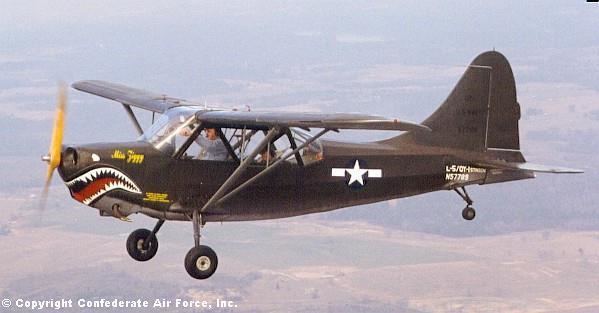 | ||
Stinson l 5 sentinel 1942
The Stinson L-5 Sentinel was a World War II era liaison aircraft used by all branches of the U.S. military and by the British Royal Air Force. Along with the Stinson L-1 Vigilant, the L-5 was the only other American liaison aircraft of World War II that was purpose-built for military use and had no civilian counterpart. All other military liaison airplanes adopted during World War II were lightly modified "off-the-shelf" civilian models.
Contents
- Stinson l 5 sentinel 1942
- Design and development
- Construction
- Operational history
- Variants
- Aircraft markings
- Operators
- Survivors
- Specifications L 5
- References
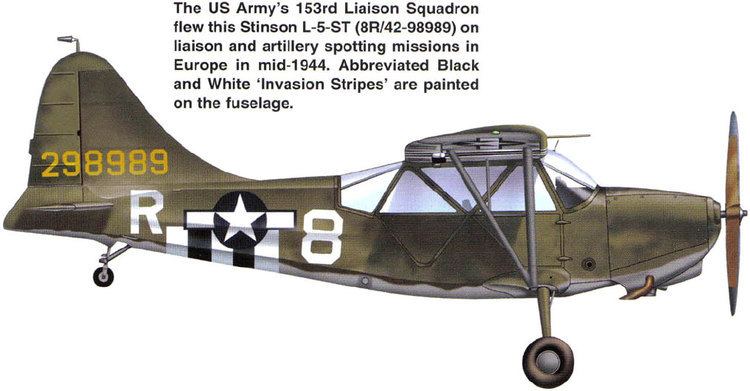
Design and development

The origins of the L-5, affectionately known as the "Flying Jeep", can be traced to the prewar civilian Stinson HW-75. The 75 horsepower civilian high-wing design was built by the Stinson Aircraft Company at Wayne, Michigan and first flew in 1939. The HW-75 featured two seats up front side-by-side, and a third "jumpseat" in the rear on which a small passenger could sit sideways. The design was easy to fly. Shortly after the introduction of the HW-75, Stinson became a subsidiary of the Vultee Aircraft corporation. Under Vultee management, the HW-75 was equipped with an 80-horsepower four-cylinder engine for the 1940 model year and the HW-75 became known as the Model 105 "Voyager", touting its 105 mph cruise speed. Fitted with a four-cylinder 90 hp Franklin engine for the 1941 model year, the type became known as the Model 10A. In the postwar era, the fuselage of the Model 10A was enlarged to accommodate four seats, and the four-cylinder powerplant was replaced with a Franklin 150 hp six-cylinder engine. This conversion became the Stinson Model 108 Voyager and the only civilian aircraft commercially produced by Stinson after WWII.
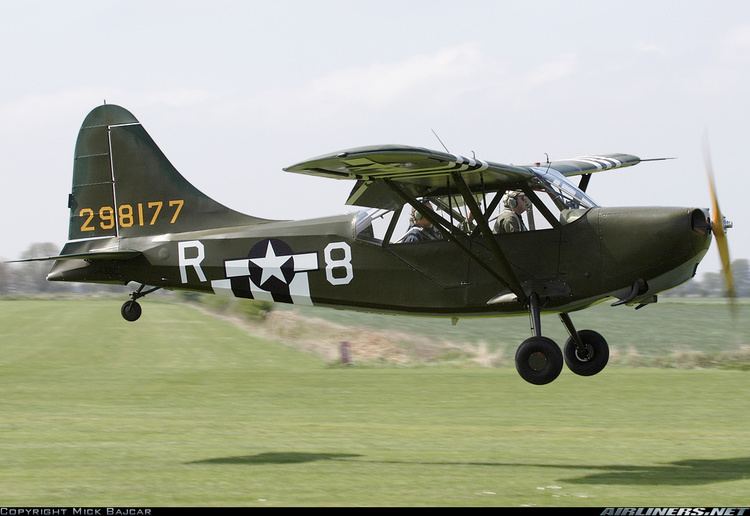
Six examples of the Model 105 Voyager were equipped with 80 horsepower Continental O-170 engines and provided to the military for testing under the experimental designation YO-54. Evaluated by the Air Corps in 1940 for potential use as a low-cost short-range observation aircraft, it failed to meet performance requirements. The Voyager was then completely re-engineered by Stinson into a much stronger and more powerful tandem-seat airplane that met rigorous Army engineering handbook standards for the design of military aircraft. The prototype, designated as the Model V-76 by Vultee / Stinson was accepted by the military after accelerated service trials and entered into service in December 1942 as the Army O-62 ('O' for observation). The L-5 carried a pilot and observer in a tandem-seating configuration, which was preferred by the military for observation work.
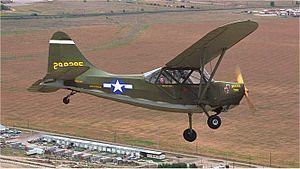
In March 1943, with the creation of the liaison category of light observation aircraft (previous examples came from Taylorcraft Aircraft as the L-2, and from Aeronca as their L-3, along with the numerous Piper L-4) the designation for Stinson's new purpose-built military design was changed to the L-5. The primary purpose as a liaison aircraft was courier and communication work, artillery spotting and casualty evacuation. The fuselage of later models was redesigned so the aircraft could also be used as an air ambulance, or for cargo work. With a wider and deeper rear fuselage section and a large rear door that folded downward, a litter patient or 250 pounds of cargo could be quickly loaded aboard.

The L-5 series was manufactured between December 1942 and September 1945, during which time 3,590 of the unarmed two-seaters were built for the United States armed forces, making it the second most widely used light observation aircraft of the war behind the Piper L-4 Cub.
Construction
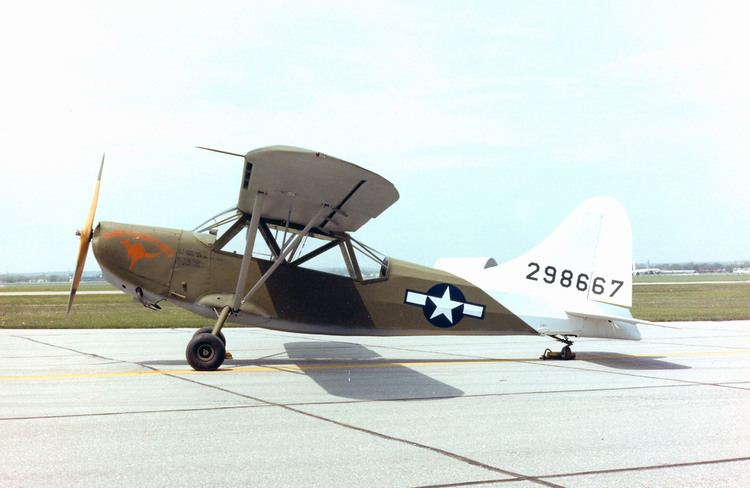
The fuselage was constructed using chrome-moly steel tubing covered with doped cotton fabric and the wings and empennage were constructed of spruce and mahogany plywood box spars and plywood ribs and skins, also covered with fabric. The use of aluminum, which was in critically short supply and more urgently needed for other aircraft, was limited to the engine cowling, tail cone, framework for the ailerons, rudder and elevator and the landing gear fairings. The L-5 was powered by a six-cylinder 190 horsepower Lycoming O-435 engine.
Operational history
Capable of operating from short unimproved airstrips, the L-5 "Sentinel" delivered personnel, critical intelligence and needed supplies to the front line troops. On return flights, wounded soldiers were often evacuated to rear area field hospitals for medical treatment, boosting the morale of combat troops fighting in remote areas. L-5s were also used for aerial photography, controlling vehicle convoys, para-dropping food, medical supplies and ammunition, laying communication wire, distributing propaganda leaflets, spraying pesticide, transporting prisoners, and directing fighter-bombers to ground targets. The L-5 was also popular with Generals and other high-ranking officers for fast, efficient short-range transportation.
During the Battle of Okinawa, L-5s operated from an LST using the Brodie landing system which allowed a light aircraft to take off and land without a flat surface by snagging a wire hung between two booms. One of the L-5s that used the Brodie system off Okinawa is now on display in the Boeing Aviation Hangar facility of the Smithsonian's NASM's Udvar-Hazy Center annex at Dulles Airport just west of Washington, DC.
The USAAF, US Marines, and US Navy used this aircraft in the European, Pacific, and Far East theaters during World War II, and in Korea during the Korean War.
The Navy and Marine version of the L-5 through L-5E were designated OY-1, and all these aircraft has 12-volt electrical systems. The 24-volt L-5G became the OY-2. Neither the L-5G nor OY-2 saw combat during World War II because production did not begin until July, 1945, just weeks before the war ended, but they were used extensively during the Korean War. The British Royal Air Force (RAF) procured 40 L-5s and 60 L-5Bs, and designated them Sentinel Is and Sentinel II's respectively. These aircraft were used exclusively in the India-Burma theater of operations.
After World War II, the L-5 was widely used by the Civil Air Patrol for search and rescue work. Many other countries also received L-5s after the war, particularly India which received 200. A number of these went to Pakistan after the partition of India in 1948. From 1950 in India, L-5s were used by flying clubs to teach civilian pilots until about 1973 when a lack of spares forces their retirement.
Variants
Five versions of the Sentinel were produced for the U.S. Army Air Force (USAAF); the L-5, L-5B, L-5C, L-5E and L-5G. There was no official L-5A variant as is often reported because the designation was intended for a version of the aircraft that was never built. Nonetheless, many people in and out of the military still refer to the standard "observer" version of the L-5 as an L-5A. Like the L-5A, the L-5D was a planned version that was not adopted. A single L-5F was an L-5B equipped with an experimental low-noise "stealth" propeller and exhaust system for research purposes. The L-5B through L-5G models were modified to carry a litter patient or light cargo, or a rear seat passenger sitting in the normal position. An L-5H version was on the drawing boards at Stinson when the war ended, and it never reached the prototype stage.
Aircraft markings
Standard camouflage as delivered from the factory was non-specular "Bulletin 41" medium gray #43 undersides with olive drab #41 above, broken around the edges of the wing and tail surfaces with medium green #41. Stars, or "stars and bars" were applied to both sides of the fuselage and on the upper left and lower right wingtips. The USAAF number appeared on both sides of the vertical stabilizer in either yellow or black. The USMC number appeared in smaller size in black only. Most aircraft were repainted silver during the post-World War II period. Some Marine Corps and Navy aircraft painted overall non-specular Sea Blue. A variety of unit identification markings including nose art were applied in the field. Interior surfaces were generally finished in yellow-green chromate primer and slightly darker ANA 611 "interior green". Instrument panels were "raw" phenolic sheet naturally matte black in color.
Operators
Survivors
Today there are about 300 known examples left worldwide and less than half are in flying condition. A group called the Sentinel Owners and Pilots Association is dedicated to the preservation and enjoyment of this aircraft type.
Specifications (L-5)
Data from March Field Air Museum website
General characteristics
Performance
Armament
None (technically). Some aircraft had jury rigged, anti-tank rocket launchers (mainly bazookas) installed and used with success against ground targets in WWII.
